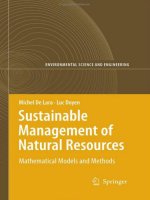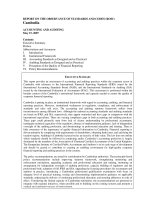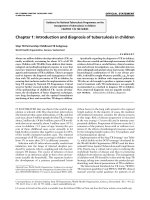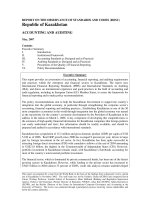TRAINING VISIT REPORT ON SUSTAINABLE MANAGEMENT OF PLANTATION FORESTS " pptx
Bạn đang xem bản rút gọn của tài liệu. Xem và tải ngay bản đầy đủ của tài liệu tại đây (730.14 KB, 11 trang )
Ministry of Agriculture & Rural Development
TRAINING VISIT REPORT ON
SUSTAINABLE MANAGEMENT OF PLANTATION FORESTS
Australia, 18 March – 6 April 2007
Vu Tan Phuong
1
, Research Centre for Forest Ecology and Environment (RCFEE), Hanoi
Le Anh Tuan, Research Centre for Tree Breeding and Improvement, Hanoi
Pham Xuan Dinh, Centre for Forest Research and Production, Dong Ha, Central Vietnam
SUMMARY
This report is an output of the training visit in Australia under the ongoing project “Sustainable and
profitable development of acacia plantations for sawlog production in Vietnam” and it refers to
solving problems for forest research and development in Western Australia. It is seen that three (3)
major problems challenging forest development and requiring for the research implementation in
Western Australia are soil salinilization, rapid decline of native timber production and water deficit.
To solve such problems, a number of researches (strategic and applied research) is developed and
implemented with strong involvement of multi-sciences, particularly strong linkage of soil sciences,
silviculture and genetics and close cooperation of management organizations and private forest
companies. The research program has produced good knowledge and understanding on soil fertility
management and plantation water use and the research results are effectively used for forest plantation
management and development.
INTRODUCTION
The training visit was conducted in Australia from 18 March to 6 April 2007 as a part of the ongoing
CARD VIE 032/05 project “Sustainable and profitable development of acacia plantations for sawlog
production in Vietnam” implemented by Centre for Environment and Life Sciences (CSIRO) through
joint venture of ENSIS and Forest Science Institute of Vietnam (FSIV). The objectives of the training
visit are i) to know how the problems regarding plantations development are defined, ii) to understand
research development and involvement of multidiscipline sciences to solve the problems, and ii) to
know how the results are utilized by the concerned agencies/companies.
1
Detailed contact: RCFEE. Add.: Dong Ngac – Tu Liem – Hanoi, Vietnam. Tel.: +844 755 0801; Fax.: +844 838 9434;
Email:
; www.rcfee.org.vn
1
To achieve these objectives, a number of scientific research results and papers related to research
programs on soil nutrient, silvicultural measures and genetics as the base for sustainable plantation
development were presented and discussed during the course of the training. In addition, a field visit
to several experiment sites and intensive discussion were also held for better understanding on
approach and methods of solving the defined problems (see appendices for itinerary and list of person
met).
This report was prepared to summarize the main findings on researches development and utilization of
research results to underpin sustainable forestry development in Australia, particularly in planted
forests in Western Australia.
OVERVIEW OF FORESTS AND FORESTRY OPERATION IN AUSTRALIA
Australian forests cover an area of about 164 million hectare, accounting for 21 percent of its
continent. Of this total forests area, the native forests area is about 163 million hectare and planted
forests area is estimated at 1.6 million hectare. About 99 percent of native forests area is broadleaf and
most of native forest areas are dominated by eucalyptus species, followed by acacia species and then
melaleuca species and the native forests are mainly designated for nature conservation. In contrast,
about 60 percent of plantation areas are established with exotic tree species for production of hard and
soft wood (Bureau of Rural Sciences 2004).
The major tree species for hardwood
plantation is Eucalyptus globulus,
estimating at 21 percent of its area,
followed by E. grandis and E. niten.
Also the main tree species for softwood
plantation is pinus radiata, accounting
for about 49 percent of plantation area
and then P. elliottii, P. pinaster, P.
caribaea, etc.
Plantation area developed quickly since
1950, particularly in recent years through
private investment. Although planted
forests area occupies only about 1
percent of total Australian’s forest area
but it provides about 70 percent of the
sawnwood produced in Australia.
Fig.1: Forest types of Australia
As data in 2002, the value of primary forest production was $1.3 billion and value of wood production
contributed 1 percent of GDP to economy or $5.6 billion. The value of turnover in forest product
industries was $15 billion. Since 1990s a total amount of $6.5 billion has been put into the forest
sector by the domestic and foreign investment that created employment for 70,000 – 80,000 people
(Bureau of Rural Science 2004).
2
INDENTIFICATION OF PROBLEMS RELATED TO FOREST DEVELOPMENT
State government research agencies in previous decades found that there are several existing
problems/limitations for forest development, particularly plantation establishment and/or sustainable
land uses. These include:
● Soil salinization is seriously incurred in area of Southern Western Australia. It is recognized
that the cause for this is widespread clearing of deep-rooted native vegetation and replacement
with shallow-rooted annual crops, leading to “leakage” of water through the profile and rising
saline water tables. According to statistical data, about 20 million ha was cleared and found to
have existing or potential salinity problems (John McGrath 2007). This problem has caused
death of trees in plantations and there is the potential for serious expanding of salinity risk by
2050 (see Fig.2). Beside this, other factors limiting forestry development in Western Australia
are infertile soils (mainly sandy soils) and unfavourable climate conditions, for example low
rainfall and high evaporation.
Fig. 2. Current and forecast areas of high risk of dryland salinity in Western Australia (figure
provided by Dr John McGrath)
● Rapid decline of native timber production was found to be considerable threats to industry
due to over-harvesting and change of forest status from productive to reserved. According to
the forecast, looming deficit of structural timber may happen in the coming years. A deficit of
about 200,000 m
3
of timber or 500,000 m
3
of sawnwood is estimated by the year of 2030
because of strong population growth resulting in high demand for housing.
● Water competition between plantations and farmland is becoming an urgent concern as
rapid expansion of plantation establishment to fulfill increasing timber demand. Therefore, it
is strongly asked for measures for sustainability of plantation productivity while ensuring
water availability, particularly in dryland of Western Australia.
3
DEVELOPING RESEARCH TO ADDRESS THE IDENTIFED PROBLEM
To solve such mentioned urgently problems for forestry development and sustainable land uses, a
number of researches directly addressed the problems has been developed. A model of joint research
is formed by active involvement of SCIRO/Ensis, state government organizations and private forest
companies, particularly the close cooperation and link between concerned multi-disciplinary sciences.
In this context, it is recognized that there is a good strategic and applied-multi disciplinary research
involved scientists to focus researches on soil fertility dynamic, silviculture and genetics for
forestry/land uses. These are most important and provide reliable knowledge and understanding on
soils, silviculture and genetics for better forestry development. The followings summarize researches
developed to underpin the plantation management.
● Long-term strategic research development:
Understanding on soil nutrient and water is known to be the key for the successful
development of plantation. To understand the change in soil properties and soil nutrient, a
long-term research program was developed by CSIRO and started in 1990s. The objective of
this research program is to understand soil nutrients under planted forests (mainly eucalypts
and pines). A network of 30 paired sites representative for a wide range of site productivity is
established to observe the changes of soil nutrient and impacts of land uses on soil nutrient.
The major nutrient parameters for research are total nutrients, available nutrients, N, P, soil
carbon, etc. In addition to that a network of harvest residue management experiments is also
set up to examine the impacts on soil fertility and productivity.
This research program has been implemented by involvement of multi-disciplinary scientists
in close collaboration with government agencies and industry. The program has so far been
completed for the second rotation and being continued in the third rotation. The knowledge
and understanding gained through the research program are used i) to understand key drivers
for sustainability and productivity, ii) capture knowledge into model to support decision
makers.
With regard to water issue, fast expansion of mono-culture plantations of exotic tree species
(mainly E. globulus) in south western of Australia in ex-pasture land areas has raised concerns
about negative impacts of plantation on water and soil fertility. Also there has been the
evidence for water deficit due to drought deaths of the plantations. To understand this, the
research on plantation water use is carried according to water gradient. Five (5) research sites
are laid out in selected areas of southern Western Australia, representing for different climate
conditions (low rainfall and high evaporation; high rainfall and low evaporation; and low
rainfall and low evaporation).
The theory “water balance” is applied to examine water amount used by plantations with
different stocking density. It is assumed in the research experiment that silviculture can
optimize returns and manage the risk (water deficit). The research has monitored a number
of parameters on plant physiology (LAI – Leaf Area Index, sapflow etc) for determining
plantation water use. The research experiments on plantation water use are conducted focusing
4
on three (3) stocking densities (300, 600 and 1200 stems per hectare) throughout 5 research
sites.
All research results on soil nutrients and water are captured for modeling. CABALA model is
one of the examples and has become a most effective tool for forestry development and
management.
● Applied research development:
As mentioned above, a large area in West Australia is being affected by salinity, causing low
crop productivity and in some cases land become not arable. The cause for such problem is the
increase of watertable following extensive vegetation clearing which brings up the salts to
surface layer of the soils. From this point of view, the applied research is being conducted to
control salinity by tree planting, reducing “leakage” of water through the soil profile. To solve
such problem, an applied research program is developed using tree planting as the measure
for controlling the watertable and thereby salinity is controlled. This research is a good model
of combining breeding and silviculture techniques.
Breeding of Acacia saligna is being implemented at two trial sites including one provenance-
progeny trial on a farmer’s farmland (Mr. Matt Edmonds). The farm is located at Bolgart,
about 200 km north-east of Perth, where annual rainfall is about 400 mm and the climate is
too dry for E. globulus. The trial tests a total of about 400 open-pollinated families of A.
saligna collected.from many provenances across the natural range of the species. On Mr
Edmonds farm, some species of eucalypt and melaleuca have also been introduced to plant in
the salinity affected areas to see how these species react to such salty environments.
Acacia saligna progeny trial on Mr Matt Edmonds farm at Bolgart, Western Australia
5
The trial is a replicated trial with 5-tree line plots of the different families. Very major
differences between families and provenances were obvious at age 1 year after planting.
A model of controlling salinity through tree planting (see photo below) is carried out in
pasture land (Mallee site, about 15 km west of Wongan Hills on the Piawanning Road). Two
species of mallee eucalypts are selected for planting. A planting strip of 6 tree rows is
established along the contourlines. In addition to the salinity control, other commercial values
of these species are material for oil production, panel wood and energy.
Beside efforts made by the scientists, a close cooperation of government and private companies can be
considered the importance for the success. It must be noted that most research sites are set up in the
plantations of the private companies and the funding support also given to the research
implementation by the companies under certain agreement.
Planting mallee eucalypt species E. kochii in strip to control salinity in pasture land
SCIENTIFIC RESULTS TO DATE AND RESEARCH RESULTS UPTAKE BY
TARGET USERS
Through the researches addressing the defined problems for forestry plantations and land uses, the
followings are seen as the invaluable results:
● Good knowledge and understanding on soil nutrient and impacts of plantations/land uses on
soil nutrients. The key findings are: i) small changes in soil fertility under different land use
6
management (plantation forestry compared to agriculture), ii) no major changes in soil carbon
and total nitrogen and phosphate, iii) harvest residue management (slash management) give
significant impacts on growth in low fertility sites and no influence on the growth in higher
red earth soils. Retention of residue contributes additional amount of nitrogen mineralized in
the soils.
● Water deficit can be managed through silviculture measures by reducing stocking density of
plantations and/or proper thinning while sustaining the productivity. The important research
results of water use for E. globulus plantation found that the same productivity for plantation
with a density of 600 trees/ha and plantation with 1200 trees/ha.
● Salinity control can be managed by tree crop establishment and with species selection and
breeding to yield commercial products so that tree plantations are profitability for farmers .
Tree species selection process for dryland salinity is in progress and has initial results. Acacia
saligna yielding fodder and biomass for fibreboard and energy, and mallee eucalypts which
yield eucalyptus oil, biomass and energyt from coppice harvests. are promising for dryland
salinity. A model of strip planting with mallee eucalypts in crop land is has been shown to
control salinity while enabling growing of crops such as wheat to continue.
Regarding the research result uptake, it is seen that the results have been effectively captured by
development of modeling and applied by management body for decision making and planning and
forest companies in practical way. The way of using research results is as below:
● Formulation of CABALA model (CArbon Balance and Allocation) by integrating
understanding of carbon, nitrogen and water cycle to support silviculture decision.
● The Forest Products Commission, the management agency taking responsibility for forest
management in Western Australia, utilizes the research results for industry development plan
and catchment scale planning (by species based on land capability, climate conditions etc);
● The benefits for the research partners (private forest companies) are the application of
CABALA model and consultation advices as well as the best practice for harvest residue
management for the plantation development.
SITUATION OF SOLVING/AMELIORATING THE PROBLEM
Although good understanding and findings gained through the researches have contributed to solve the
mentioned problems for forestry development in Western Australia, but there still exit
limitation/constraints for further research. The major limitations are:
● Researches undertook for one rotation and therefore there may be a restriction for the gained
knowledge and understanding of soils and plantation water uses for sustainability of forests
plantations and water;
● Silvicuture measure for reduction of plantation water use can be seen as immediate solutions.
However, tree breeding, for purpose of reducing plantation water uses while satisfying wood
quality and yield, is just in progress and would take time. The harmonization of timber
production and water availability needs to be put into consideration.
● Salinity management is, to some extent, focusing on salinity control for the unaffected and/or
potentially affected areas rather than affected areas. A model of strip planting to control
7
watertable is so far on small scale. Therefore, it would be required for further measures to
remedy large affected areas and/or scale up strip planting model. For there to be a large scale
impact, the tree plantings must yield commercial products so that farmers can earn sufficient
income to invest in large areas of plantings.
LESSONS LEARNED
● Good development of strategic and applied research program which addresses the problems
related to sustainable planted forests and water use. Also a good research team and strong
involvement of multi-sciences as well as close cooperation between researchers, land
management agencies and industry companies are required to solve the research problems.
● Knowledge and understanding derived from the research are invaluable to develop modeling
supportive for decision making and planning as well as forest development.
● A close collaboration of soil sciences, silviculture and genetics is a key for successful planted
forests development and better forestry.
ACKNOWLEGMENT
We would like to express our sincere thanks and appreciation to Dr.Ha Huy Thinh, Director of
Research Centre for Tree breeding and Improvement for giving acceptance and opportunity to
participate the training course. We also thank a lot Dr. Chris Harwood for all convenient arrangements
and kindness. Our deepest thanks to Dr. Sadanandan Nambiar, Dr. Chis Beadle, Dr. Daniel Mendham,
Dr. John McGrath, Dr John Bartle Dr. Philip Smethurst and other resource people for useful
presentation and assistance during the training course.
APPENDIX 1. TRAINING PARTICIPANTS AND TIMETABLE
PARTICIPANTS:
All are attached to the Forest Science Institute of Vietnam
Mr. Vu Tan Phuong (Acting Director, Research Centre for Forest Ecology and Environment, Hanoi)
(28
th
-31
st
March only)
Mr. Dang Thinh Trieu (Researcher, Research Division for Silviculture, Hanoi)
Mr. Le Anh Tuan (Researcher, Research Centre for Forest Tree Improvement, Hanoi)
Mr. Vu Dinh Huong (Researcher, Sub-institute of Forest Science, Ho Chi Minh City)
Mr. Pham Xuan Dinh (Researcher, Centre for Forest Research and Production, Dong Ha, Central
Vietnam)
8
CARD Project VIE 032/05
Visit Itinerary, Western Australia
Sunday March 18
Arrive Perth. Rest day
Monday March 19
CSIRO Centre for Environment and Life Sciences (CELS), Floreat Introduction to CELS,
CSIRO and Ensis Discussion – Research approach, case study of Drought Risk project
Discussion – case study of 2
nd
and 3
rd
rotation management research Discussion – integration
into decision support tools
Tuesday March 20 – Thursday March 22
CELS Forest industry development - the Mt Gambier experience – presentation by Dr
Nambiar. Depart for field tour to E. globulus plantation forestry research sites, returning
Thursday 22/3/2007 at around 6 pm
Friday March 23
Forest Products Commission, Rivervale Presentation on the Strategic Tree Farming Initiative,
John McGrath, FPC
Saturday March 24
Free day
Sunday March 25
Day trip to Rottnest Island (hosted by Chris Harwood)
Monday March 26
Discussions, report writing - Floreat site
Tuesday March 27
Field trip with John Bartle to discuss development of Acacia saligna industry, visit to progeny
trial at Bolgart, and mallee eucalypts at Wongan Hills, North East of Perth
Wednesday March 28
Depart Perth for Hobart.
Arrive 2115 in Hobart from Perth via DJ292/DJ378
Thursday 29
th
March
0845 Welcome by Site Leader, Dr Philip Smethurst (Conference Room)
0900 Safety induction (in Conference Room) (Craig Baillie)
0910 Tour of the CSIRO-ensis Hobart Laboratory (CB) (Three 15-minute presentations across
range of topics)
1000 Morning coffee/tea
1030 Producing an industry in Tasmania based on solid wood from eucalypt plantations - growing,
protecting, defining and sustaining the resource (CB).
1245 Lunch
Session on Wood Quality
1330 Wood coring (behind CSIRO-ensis laboratory) (Des Stackpole)
9
1400 Wood Quality laboratory - processing wood cores (Linda Ballard)
1500 Afternoon coffee/tea
1515 Walk to Central Science Laboratory
1530 Near infra-red spectroscopy at Central Science Laboratory (Linda Ballard)
1700 Return to Wrest Point
1930 Welcome dinner hosted by CSIRO-ensis
Friday 30
th
March
0730 Pick up from Wrest Point (CB)
0745 Breakfast
0900 Presentations based on E. globulus to Veracel (see Veracel program in attached Appendix. To
be held in Conference Room)
1245 Drive to Pittwater for barbeque lunch
1345 The Pittwater experimental site:
Canopy
1 Background to research (Chris Beadle)
2 Experimental design and management of treatments (Dale Worledge/Stephen Paterson)
3 Understanding root development and water uptake (Tony O’Grady)
4 Competition between trees in the stand (Tony O’Grady)
Plantation
5 Wood formation (Geoff Downes)
6 Physiological responses to defoliation (Audrey Quentin)
7 Spectral responses to stress (Karen Barry)
8 Soil sampling (Malcolm Hall) (The processing of these samples will form part of the
demonstration in the Analytical Laboratory on Wednesday 4
th
April)
1630 Return to Wrest Point
Saturday 31
st
March
0800 Pick up from Wrest Point (CH, CB)
Breakfast hosted by CB (62 Colville Street), then visit Salamanca Market, Sullivan’s Cove,
Tasmanian Museum
1230 Lunch
1330 Free time
(Note: Mr Phuong returned to Vietnam on Saturday 31 March so as to attend an important meeting)
Sunday 1
st
April
0800 Pick up from Wrest Point (CH, CB)
1 Visit to the Southern Forests. This will include:
2 Airwalk
3 Native forest management (The Warra)
4 Old-growth forest
5 Pruned and thinned eucalypt plantations
1700 Return to Hobart
Monday 2
nd
April
0900 Southern Midlands of Tasmania. Tree decline and reestablishment/reinvigoration of native
species (CB).
10
1130 Integrating trees into the farming landscape: an example using Pinus radiata to increase farm
productivity at the same time capturing wood values (David Bower, Private Forests Tasmania
at “Woodrising”, Cressy owned by Rob Henry) (to be confirmed)
1300 Lunch
1500 Visit to Forest Enterprises Australia – hew-saw technology (Ross Barlow)
1700 Drive to accommodation at Annabel’s, Scottsdale
Tuesday 3
rd
April
0830 Lisle plantation – a thinned E. nitens plantation (Chris Beadle)
1030 Forestry Ecocentre incl. Tour of Centre and presentation on Forestry in N-E Tasmania (Peter
Bird)
1215 Lunch at Ecocentre
1315 Depart for Hobart via East Coast
1530 Spring Vale Vineyard, Cranbrook (45 minutes) (confirmed)
1815 seedEnergy Clonal Seed Orchard of E. globulus, Meadowbank
Wednesday 4
th
April
0830 Pick up from Wrest Point (CH, CB)
0845 Seminars from Trainees (Mr Huong)
1030 The Analytical Laboratory, 2+ hours (Ann Wilkinson)
1245 Lunch
1330 Completion of trip reports
Thursday 5
th
April
0500 Pick up from Wrest Point
0600 Depart Hobart DJ367/841 to Sydney
Friday 6
th
April
1520 Depart Sydney for Vietnam
11









